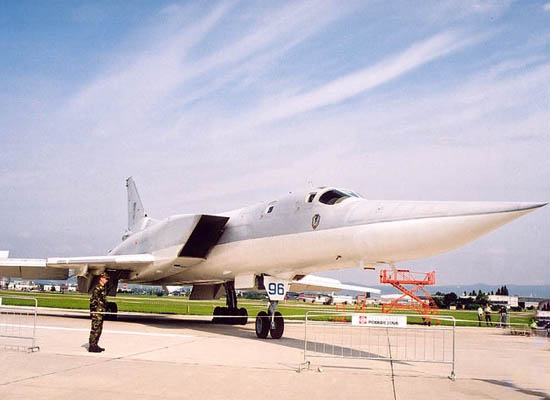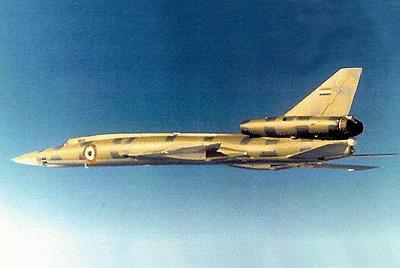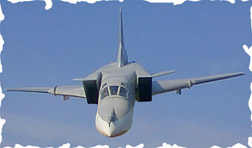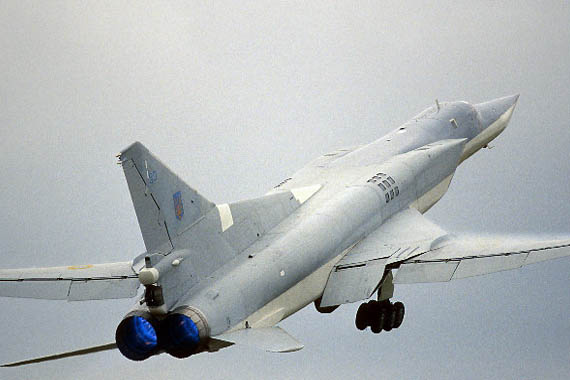مهدي كياني
کاربر فعال مهندسی هوافضا
توپولوفTu-22m3

در حالی که بسیاری از هواپیماها و هلیکوپترهای رزمی در زمان جنگ سرد به عنوان یک پادزهر در برابر یکدیگر توسعه می یافتند، هواپیمای بمب افکن توپولف tu- 22-m3 بک فایر هیچ گونه همتای خارجی ندارد و باید آن را در رده ای بین بمب افکنهای استراتژیک و بمب افکنهای خط مقدم حامل موشک قرار دارد .
وضعیت خاص جغرافیایی روسیه همواره نیاز به توسعه یک شاخه هوایی دوربرد را ایجاب می نمود . این شاخه میبایست با هواپیماهای جدید و پیچیده تر با توانایی پرتاب موشک و بمب به سوی اهداف مستقر در یک شعاع 2500 تا 3000 کیلومتری و مقابله با گروههای ضربتی ناوهای هواپیما بر دشمن در سطح دریاها و اقیانوسها تجهیز می شد . از آنجایی که بمب افکن tu-22 نیازمندیهای عادی مورد انتظار از یک بمب افکن دوربرد را کاملا برآورده نکرده بود . این امر به توسعه یک هواپیمای پیشرفته تر منجر شد .
هواپیمای یشرفته می بایست دارای برد دست کم 5000 کیلومتر و سرعت بیش از 2 ماخ در ارتفاع زیاد بوده توانایی پرواز در ارتفاع با سرعت پایین فروصوت را به منظور نفوذ به مواضع دفاعی دشمن داشته و قادر به حمل یک محموله رزمی 20 تنی شامل موشکهای کروز دوربرد بمبهای معمولی و ویژه و نشست و برخاست از باندهای غیرآماده باشد . از ابتدا روشن بود که هواپیمایی با بال متحرک می تواند مناسبترین طرح برای این منظور باشد .در سال 1967 دفتر طراحی تجربی ( ( EDB توپولف شروع به توسعه هواپیمایی با نام TU-22M نمود (نیروی هوایی شوروی پیشین پذیرفت که کار بر روی هواپیمای جدید و تضمین مالی برنامه در چارچوب برنامه نوسازی هواپیمای TU-22 قرار گیرد ) سر طراح توپولف در آن هنگام دیمیتری مارکوف بود . TU-22M را باید هواپیمای کاملا ویژه ای به شمار آورد .

هنگامی که اجداد این هواپیما حیات خود را به طور معمول از مرحله طراحی روی کاغذ و ساخت نمونه اولیه در دفتر طراحی آزمایشی توپولف در مسکو شروع می کردند با هدف صرفه جویی در وقت بی درنگ پس از تکمیل آخرین هواپیمای TU-22 مونتاژ نخستن TU-22 در خط تولید گوربانف در کازان آغاز شد . روزهای پر التهاب آزمایشها شامل آزمایشهای موتور گردانی(engine runups ) و بازرسیهای مختلف و پیچیده ی سخت افزاری پیچیده به زودی پایان یافته و در روز آفتابی 30 اوت 1969 نخستین خدمه ی بمب افکن جدید حامل موشک (خلبان وی باریسف کمک خلبانبی ورییمی ناو بر ال سیکاچف وناوبر / کاربر مخابرات ک.شرباکف ) بر روی صندلی های خود در کابین هواپیما قرار گرفتند. پس از دریافت اجازه پرواز هواپیما ی بمب افکن با قدرت تمام شروع به اوجگیری نمود ونخستین جای پای خود را در آسمان بر جای گذاشت. در پی این پرواز یکدوره پروازهای آزمایشی خطرناک و طاقت فرسا آغاز شد .این پروازها با قرار دادن هواپیما در مرز مانورهای ممنوع انجام شده وخدمه پروازی آزمایشگر هواپیما نیز با به کار گرفتن تمامی توان خود برای چیره شدن بر مشکلات موجود به سختی تلاش نمودند.در فوریه 1973دو فروند هواپیمای tu-22moبه مرکز آموزشهای هوایی دور برد که محل آموزش خدمه ی پروازی برای واحدهای هوایی تاکتیکی بود منتقل شد.

سپس هواپیمایی نیروی دریایی تعداد کمی از نمونه جدید تر این هواپیما tu-22m1 را پذیرفت. در همین هنگام کارهای مقدماتی شروع تولید بمب افکن جدید tu-22m2 درکارخانه گوربانف در دست انجام بود هواپیمایی که بعدا" نخستین برنامه ی ارتقای گسترده ی سری tu-22m بر روی آن انجام شد و سپس در واحدهای هوایی دور برد وهواپیمایی نیروی دریایی به خدمت گرفته شد. در جریان آزمایشهای سیستمهای جنگ افزار این هواپیما یک موشک خا- 22 ( kh-22 )شلیک شده از آن سوراخی به قطر بیش از 20 متر مربع در یک سمت کشتی هدف ایجاد کرده درون آنرا به آتش کشید وبا تولید فشار متمرکز به عمق 12متری آن نفوذ کرد.انواع متعلق به نیروی دریایی همچنین در نقش مین گذاری در مسیر ناوگان دریایی دشمن نیز به کار گرفته میشود.با فرا رسیدن سال 1976 ودر جریان مذاکرات سالت-2در ژنو وزیر وقت صنایع هوایی شوروی پیشین تصمیم به اجرای یک پرواز آزمایشی با هواپیمای tu-22mرابا هدف تعین بیشترین برد پروازی با انجام دو سوختگیری هوایی اعلام نمود. سوختگیری هوایی بوسیله ی هواپیما های سوخت رسان میا سیشف m4 و3m3 با موفقیت به اجرا در آمد جالبترین بخش این عملیات در مسیر برگشت هواپیما بود که سوختگیری هوایی در درون ابر کامل(ده دهم )انجام شد. با انجام این پرواز 15 ساعته هواپیمای tu-22mسالم به پایگاه اصلی خود باز گشت با اصرار وپافشاری طرف امریکایی در مذاکرات سالت -2 پس از مدتی هواپیما های tu-22mاز توانایی سوختگیری در حین پرواز محروم شدند.

برنامه ی موفقیت آمیز نو سازی پس از مدت اندکی به تولید هواپیمای رزمی کارامدtu-22m3با مشخصات برتر منجر گردید . هواپیما های tu-22m2وtu-22m3در جریان جنگ افغانستان نیز به کار گرفته شده و در آنجا نقش پشتیبانی هوایی را برای نیرو های زمینی ایفا نمود ند . مدلهای بر گرفته شده از tu-22m3 شامل یک نوع شنا سایی دور برد می باشد که به منظور شنا سایی هوایی تاکتیکی و استراژیک برای تمام نیرو های مسلح بر فراز پهنه های عملیاتی روی خشکی و دریا به کار گرفته می شود. این هواپیما می تواند عملیات شنا سایی را در همه گونه شرایط جوی و در ارتفاع بالا یا پایین در هر فصل و در هر ساعتی از روز انجام دهد و در هر دو صورت به طور مستقل و یا به عنوان قسمتی از یک گروه رزمی قادر به اجرای ما موریت می باشد.هم اکنون مجتمع مهندسی و پژوهشی هواپیمایی توپولوف 2 کارهای زیادی را به منظور نوسازی هواپیمای tu-22m3 آغاز کرده است. این تلاشها شامل تجهیز هواپیما با وسایل ناوبری و سیستمهای هدایت اتش بسیار پیشرفته سیستمهای جنگ الکترونیکی و سیستمهای جدید جنگ افزار می باشد.

این قبیل سیستمها که شامل جنگ افزارهای هدایت شونده بسیار دقیق نیز می شوند tu-22m3 را تبدیل به بمب افکنی موثر و نیرومند می نماید. در عین حال این هواپیما شایستگی خود را در امور کاملا"مسالمت آمیز و صلح جویانه نیز به اثابت رسانده است. Tu-22m3برای آزمایش سیستمهای نجات فضا پیما های قابل استفاده مجدد و چتر نجات نیز به کار رفته است. این سیستمها می بایست از ارتفاع زیاد و در سرعت 2 ماخ رها می شدند و tu-22m3به خوبی از عهده ی این مهم بر آمد. در نمایش هوایی 1992 مسکو (ماسایرو) مجتمع هواپیمایی توپالوف انستیتوی مرکزی دینامیک سیالات (tsagi ) و انیستیتوی پژوهشهای پروازی روسیه محصول ابتدایی مشترک خود را که یک آزمایشگر پرنده (flying testbed)بر پایه ی tu-22m3 بود معرفی نمودند. این آزمایشگر پرنده با هدف انجام پژوهشهایی در مورد یکنواخت سازی طبیعی جریان هوا بر روی بالهای رو به عقب (swept wing )نسل بعدی هواپیما های مسافر بری به کار می رود.
آزمایشها با این اهداف به انجام رسید :
1- تعین صحت اصول نظری و ارتقای روشهای محاسباتی .
2- تصحیح مکانیزم لایه ی مرزی 3 بال رو به عقب با اعداد رینولدزمختلف .
3- تعیین محدوده های مطلوب برای کارایی بالهای تولید کننده ی جریان یکنواخت هوا در محیطهای مختلف .
4- فناوری سا خت و کیفیت سطح بالهای تولید کننده جریان یکنواخت .
5- چنین اندازه گیریهایی به طور معمول با اعداد ماخ 6/0 تا 82/0 اعداد رینولدز106*14:30 زاویه ی لبه ی حمله بال 17 تا 30 درجه و در ارتفاع پروازی 5 تا 10 کیلومتر انجام میگیرد.
هم اکنون مجتمع هواپیمایی توپالوف ،انستیتو پژوهشها ی پروازی و انستیتوی مرکزی دینامیک سیالات پیشنهاد نموده اند که آزمایشگر پرنده ی tu-22m3 را توسعه داده و از آن در آزمایشهای ایرودینامیکی مدلهای با مقیا س بزرگ هواپیماهای مسافر بری آینده بهره گیری نمایند.این آزمایشگر پرنده قرار است به منظور انجام آزمایشهای زیربه کار گرفته شود :
1-مطالعه ی جدایی عبور ورابطه ی متقابل لایه ی مرزی هوا با امواج ضربه ای..
2-جستجوی راههای جدید برای کاهش اصطکاک بدنه در برابر جریان متلاطم .
3- مطالعه جریان های گردابی .
4- آزمایش مشکلات ایرود ینامیکی غیرایستا(non-staionary)
5-انجام آزمایشهای مربوط به وزن .
6- آزمایش ناثیر گاز های خروجی شبیه ساز موتور و ویژگی های ایرودینامیکی هواپیما.
7- مطالعه ی الاستیسیته ی هوا .


در حالی که بسیاری از هواپیماها و هلیکوپترهای رزمی در زمان جنگ سرد به عنوان یک پادزهر در برابر یکدیگر توسعه می یافتند، هواپیمای بمب افکن توپولف tu- 22-m3 بک فایر هیچ گونه همتای خارجی ندارد و باید آن را در رده ای بین بمب افکنهای استراتژیک و بمب افکنهای خط مقدم حامل موشک قرار دارد .
وضعیت خاص جغرافیایی روسیه همواره نیاز به توسعه یک شاخه هوایی دوربرد را ایجاب می نمود . این شاخه میبایست با هواپیماهای جدید و پیچیده تر با توانایی پرتاب موشک و بمب به سوی اهداف مستقر در یک شعاع 2500 تا 3000 کیلومتری و مقابله با گروههای ضربتی ناوهای هواپیما بر دشمن در سطح دریاها و اقیانوسها تجهیز می شد . از آنجایی که بمب افکن tu-22 نیازمندیهای عادی مورد انتظار از یک بمب افکن دوربرد را کاملا برآورده نکرده بود . این امر به توسعه یک هواپیمای پیشرفته تر منجر شد .
هواپیمای یشرفته می بایست دارای برد دست کم 5000 کیلومتر و سرعت بیش از 2 ماخ در ارتفاع زیاد بوده توانایی پرواز در ارتفاع با سرعت پایین فروصوت را به منظور نفوذ به مواضع دفاعی دشمن داشته و قادر به حمل یک محموله رزمی 20 تنی شامل موشکهای کروز دوربرد بمبهای معمولی و ویژه و نشست و برخاست از باندهای غیرآماده باشد . از ابتدا روشن بود که هواپیمایی با بال متحرک می تواند مناسبترین طرح برای این منظور باشد .در سال 1967 دفتر طراحی تجربی ( ( EDB توپولف شروع به توسعه هواپیمایی با نام TU-22M نمود (نیروی هوایی شوروی پیشین پذیرفت که کار بر روی هواپیمای جدید و تضمین مالی برنامه در چارچوب برنامه نوسازی هواپیمای TU-22 قرار گیرد ) سر طراح توپولف در آن هنگام دیمیتری مارکوف بود . TU-22M را باید هواپیمای کاملا ویژه ای به شمار آورد .

هنگامی که اجداد این هواپیما حیات خود را به طور معمول از مرحله طراحی روی کاغذ و ساخت نمونه اولیه در دفتر طراحی آزمایشی توپولف در مسکو شروع می کردند با هدف صرفه جویی در وقت بی درنگ پس از تکمیل آخرین هواپیمای TU-22 مونتاژ نخستن TU-22 در خط تولید گوربانف در کازان آغاز شد . روزهای پر التهاب آزمایشها شامل آزمایشهای موتور گردانی(engine runups ) و بازرسیهای مختلف و پیچیده ی سخت افزاری پیچیده به زودی پایان یافته و در روز آفتابی 30 اوت 1969 نخستین خدمه ی بمب افکن جدید حامل موشک (خلبان وی باریسف کمک خلبانبی ورییمی ناو بر ال سیکاچف وناوبر / کاربر مخابرات ک.شرباکف ) بر روی صندلی های خود در کابین هواپیما قرار گرفتند. پس از دریافت اجازه پرواز هواپیما ی بمب افکن با قدرت تمام شروع به اوجگیری نمود ونخستین جای پای خود را در آسمان بر جای گذاشت. در پی این پرواز یکدوره پروازهای آزمایشی خطرناک و طاقت فرسا آغاز شد .این پروازها با قرار دادن هواپیما در مرز مانورهای ممنوع انجام شده وخدمه پروازی آزمایشگر هواپیما نیز با به کار گرفتن تمامی توان خود برای چیره شدن بر مشکلات موجود به سختی تلاش نمودند.در فوریه 1973دو فروند هواپیمای tu-22moبه مرکز آموزشهای هوایی دور برد که محل آموزش خدمه ی پروازی برای واحدهای هوایی تاکتیکی بود منتقل شد.

سپس هواپیمایی نیروی دریایی تعداد کمی از نمونه جدید تر این هواپیما tu-22m1 را پذیرفت. در همین هنگام کارهای مقدماتی شروع تولید بمب افکن جدید tu-22m2 درکارخانه گوربانف در دست انجام بود هواپیمایی که بعدا" نخستین برنامه ی ارتقای گسترده ی سری tu-22m بر روی آن انجام شد و سپس در واحدهای هوایی دور برد وهواپیمایی نیروی دریایی به خدمت گرفته شد. در جریان آزمایشهای سیستمهای جنگ افزار این هواپیما یک موشک خا- 22 ( kh-22 )شلیک شده از آن سوراخی به قطر بیش از 20 متر مربع در یک سمت کشتی هدف ایجاد کرده درون آنرا به آتش کشید وبا تولید فشار متمرکز به عمق 12متری آن نفوذ کرد.انواع متعلق به نیروی دریایی همچنین در نقش مین گذاری در مسیر ناوگان دریایی دشمن نیز به کار گرفته میشود.با فرا رسیدن سال 1976 ودر جریان مذاکرات سالت-2در ژنو وزیر وقت صنایع هوایی شوروی پیشین تصمیم به اجرای یک پرواز آزمایشی با هواپیمای tu-22mرابا هدف تعین بیشترین برد پروازی با انجام دو سوختگیری هوایی اعلام نمود. سوختگیری هوایی بوسیله ی هواپیما های سوخت رسان میا سیشف m4 و3m3 با موفقیت به اجرا در آمد جالبترین بخش این عملیات در مسیر برگشت هواپیما بود که سوختگیری هوایی در درون ابر کامل(ده دهم )انجام شد. با انجام این پرواز 15 ساعته هواپیمای tu-22mسالم به پایگاه اصلی خود باز گشت با اصرار وپافشاری طرف امریکایی در مذاکرات سالت -2 پس از مدتی هواپیما های tu-22mاز توانایی سوختگیری در حین پرواز محروم شدند.

برنامه ی موفقیت آمیز نو سازی پس از مدت اندکی به تولید هواپیمای رزمی کارامدtu-22m3با مشخصات برتر منجر گردید . هواپیما های tu-22m2وtu-22m3در جریان جنگ افغانستان نیز به کار گرفته شده و در آنجا نقش پشتیبانی هوایی را برای نیرو های زمینی ایفا نمود ند . مدلهای بر گرفته شده از tu-22m3 شامل یک نوع شنا سایی دور برد می باشد که به منظور شنا سایی هوایی تاکتیکی و استراژیک برای تمام نیرو های مسلح بر فراز پهنه های عملیاتی روی خشکی و دریا به کار گرفته می شود. این هواپیما می تواند عملیات شنا سایی را در همه گونه شرایط جوی و در ارتفاع بالا یا پایین در هر فصل و در هر ساعتی از روز انجام دهد و در هر دو صورت به طور مستقل و یا به عنوان قسمتی از یک گروه رزمی قادر به اجرای ما موریت می باشد.هم اکنون مجتمع مهندسی و پژوهشی هواپیمایی توپولوف 2 کارهای زیادی را به منظور نوسازی هواپیمای tu-22m3 آغاز کرده است. این تلاشها شامل تجهیز هواپیما با وسایل ناوبری و سیستمهای هدایت اتش بسیار پیشرفته سیستمهای جنگ الکترونیکی و سیستمهای جدید جنگ افزار می باشد.

این قبیل سیستمها که شامل جنگ افزارهای هدایت شونده بسیار دقیق نیز می شوند tu-22m3 را تبدیل به بمب افکنی موثر و نیرومند می نماید. در عین حال این هواپیما شایستگی خود را در امور کاملا"مسالمت آمیز و صلح جویانه نیز به اثابت رسانده است. Tu-22m3برای آزمایش سیستمهای نجات فضا پیما های قابل استفاده مجدد و چتر نجات نیز به کار رفته است. این سیستمها می بایست از ارتفاع زیاد و در سرعت 2 ماخ رها می شدند و tu-22m3به خوبی از عهده ی این مهم بر آمد. در نمایش هوایی 1992 مسکو (ماسایرو) مجتمع هواپیمایی توپالوف انستیتوی مرکزی دینامیک سیالات (tsagi ) و انیستیتوی پژوهشهای پروازی روسیه محصول ابتدایی مشترک خود را که یک آزمایشگر پرنده (flying testbed)بر پایه ی tu-22m3 بود معرفی نمودند. این آزمایشگر پرنده با هدف انجام پژوهشهایی در مورد یکنواخت سازی طبیعی جریان هوا بر روی بالهای رو به عقب (swept wing )نسل بعدی هواپیما های مسافر بری به کار می رود.
آزمایشها با این اهداف به انجام رسید :
1- تعین صحت اصول نظری و ارتقای روشهای محاسباتی .
2- تصحیح مکانیزم لایه ی مرزی 3 بال رو به عقب با اعداد رینولدزمختلف .
3- تعیین محدوده های مطلوب برای کارایی بالهای تولید کننده ی جریان یکنواخت هوا در محیطهای مختلف .
4- فناوری سا خت و کیفیت سطح بالهای تولید کننده جریان یکنواخت .
5- چنین اندازه گیریهایی به طور معمول با اعداد ماخ 6/0 تا 82/0 اعداد رینولدز106*14:30 زاویه ی لبه ی حمله بال 17 تا 30 درجه و در ارتفاع پروازی 5 تا 10 کیلومتر انجام میگیرد.
هم اکنون مجتمع هواپیمایی توپالوف ،انستیتو پژوهشها ی پروازی و انستیتوی مرکزی دینامیک سیالات پیشنهاد نموده اند که آزمایشگر پرنده ی tu-22m3 را توسعه داده و از آن در آزمایشهای ایرودینامیکی مدلهای با مقیا س بزرگ هواپیماهای مسافر بری آینده بهره گیری نمایند.این آزمایشگر پرنده قرار است به منظور انجام آزمایشهای زیربه کار گرفته شود :
1-مطالعه ی جدایی عبور ورابطه ی متقابل لایه ی مرزی هوا با امواج ضربه ای..
2-جستجوی راههای جدید برای کاهش اصطکاک بدنه در برابر جریان متلاطم .
3- مطالعه جریان های گردابی .
4- آزمایش مشکلات ایرود ینامیکی غیرایستا(non-staionary)
5-انجام آزمایشهای مربوط به وزن .
6- آزمایش ناثیر گاز های خروجی شبیه ساز موتور و ویژگی های ایرودینامیکی هواپیما.
7- مطالعه ی الاستیسیته ی هوا .

آخرین ویرایش:












































































 144 prototype in Zhukovskiy airfield
144 prototype in Zhukovskiy airfield




























